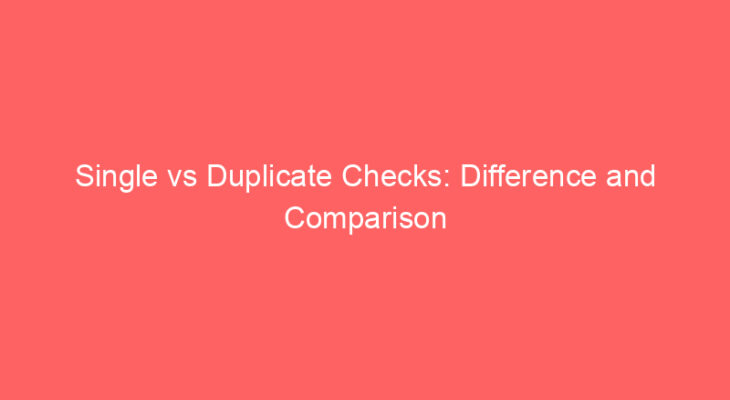Key Takeaways
- Record-Keeping Mechanism: The primary difference between single checks and duplicate checks lies in the record-keeping. Single checks are standalone checks with no additional record. Duplicate checks, on the other hand, have a second copy (a carbonless copy) underneath each check you write, creating an instant record for your reference.
- Ease of Tracking: Duplicate checks provide an easy way to track your payments as they leave a copy behind each time you write a check. This copy, while it doesn’t serve as an official record, can be helpful for personal or business record-keeping. Single checks do not provide this feature, so you need to manually record check details if you want to track them.
- Privacy and Cost: While duplicate checks offer better tracking, they can also present privacy concerns because the copies include all written details, including payee name, amount, and your signature, which could be an issue if not stored securely. Additionally, duplicate checks are more expensive than single checks due to the added convenience and paper costs.
What are Single Checks?
Single checks are standard individual checks used for one-time payments or transactions. They come in a standard checkbook format, with one check printed on each page. When writing a single check, you need to manually fill in the recipient’s name, date, amount, and sign it.
While single checks offer a straightforward and widely available payment method, they require additional effort to maintain financial records compared to duplicate checks, which automatically provide copies of each transaction. Despite the rise of digital payments, some individuals and businesses still opt for single checks for their payment needs.
What are Duplicate Checks?
Duplicate checks are a type of checkbook that includes built-in copies or duplicates of each check. When you write a check using a duplicate checkbook, the information is automatically transferred to the carbon copy below the original check. This duplicate copy serves as a record of the transaction, providing a convenient way to keep track of your expenses and maintain accurate financial records.
Duplicate checks are particularly useful for those who want an easy way to track expenses without the hassle of manually recording each transaction. However, it’s essential to keep your checkbook secure since the carbon copies contain sensitive financial information.
Difference Between Single and Duplicate Checks
- Single checks are standard checks that are used for making individual, one-time payments. Each check is unique and contains all the necessary information for a single transaction. Duplicate checks come with a built-in carbon copy or duplicate of each check. When you write a check, the carbon copy underneath the original allows you to keep a record of the transaction.
- With single checks, there is no automatic recordkeeping. Once you write a check, the information is not duplicated or retained in the checkbook itself. You need to manually record the transaction in a separate register to track your expenses. Duplicate checks provide an automatic recordkeeping system. As you write a check, the carbon copy below the original retains a copy of the information, including the payee, amount, and check number. This makes it easier to track expenses and maintain accurate financial records.
- Single checks come in a standard checkbook format, with one check per page, without any additional copies or duplicates. Duplicate checks have two or more copies of each check on a page, with a removable separator between the original and the carbon copy. This design facilitates easy recordkeeping.
- Single checks may be more convenient for individuals who prefer a simple and compact checkbook. However, they require more effort in manually recording transactions for financial management. Duplicate checks offer added convenience since they provide an automatic copy of each check, eliminating the need for immediate manual recordkeeping.
- Single checks are widely available and are the standard option for most checkbooks provided by banks. Duplicate checks are also available but may not be as common as single checks. You may need to request them specifically from your bank or check printer.
Comparison Between Single and Duplicate Checks
| Parameters of Comparison | Single Checks | Duplicate Checks |
|---|---|---|
| Manual Recordkeeping | Requires manual recording of transactions in a register. | Automatic carbon copy provides instant recordkeeping. |
| Number of Copies | One check per page, no duplicates. | Multiple copies per page, including carbon copies. |
| Checkbook Design | Standard checkbook format with one check per page. | Typically larger format with space for duplicates. |
| Convenience | Simple and compact but requires extra recordkeeping. | Offers convenient automatic recordkeeping. |
| Security of Records | Lower risk of losing sensitive information as no copies. | Higher risk, as carbon copies contain financial data. |






